Healing A Stressed Horse:
Odette's Story

Odette was the epitome of a stressed horse when we bought her. After a racing career where she lived the ultimately artificial life, she ended up at a horse fair held in our local town. This is the story of her recovery.
When we first saw Odette she was tied up in a line of other horses at a horse fair, and from outward appearances at least, she was definitely the most stressed horse there. She was the only horse visibly reacting to the injustice and horror of the situation. Horror might seem a strong word, but only when we are not looking at things from the horses point of view.
Horses are animals whose family herd is their means of survival - similar to people, although people are reaching the stage in their evolution where they sometimes choose a more solitary lifestyle. No normal horse would seek this voluntarily, apart from young stallions as part of their development in the wild. Even in this case if they could win a mare they most certainly would, and as an alternative they often live in 'bachelor' groups of other stallions. Humans have sadly disturbed the infrastructure of horse society so radically that many of us have lost sight of the value of the herd for our horses and we believe it is necessary and acceptable to treat them like merchandise.

At this particular horse sale, the horses are rarely given water let alone food, all day. The idea that their emotional needs would be met is laughable. The saddest part of this is perhaps the loss we suffer ourselves when we miss out on so much through our lack of compassion. The world is changing however and many people would only attend such a sale to rescue horses rather than sell them.
Taking on A Stressed Horse
The reason we decided to buy Odette was that we couldn't justify leaving such a stressed horse in this situation. She was kicking at whoever walked too close, and biting at anyone who tried to touch her, with ears pinned back. Her behaviour was in marked contrast to her condition which was apparently excellent. Her extra-fine coat gleamed and she looked ready to run the derby. Buying her felt like a risk because it was impossible to know how aggressive or untraceable she might turn out to be, but then it is never possible to tell how any horse will turn out for sure, and her future seemed too uncertain to leave her behind.
When she was dropped off at our yard she was so wound up that she couldn't eat. She whirled round the stable we put her in, sweating and trembling all over.

Her anxiety had become a self-perpetuating cycle and it felt right to do something similar to the 'squeeze therapy' which is used with autistic or hyperactive children (photo, right). Doubling it up with Craniosacral therapy, it was a way of accessing her system when, like a computer crashing, she couldn't listen to anything else because her central nervous system was over-loaded.

Photo, left: Using a 'squeeze therapy' type, contact-based approach to putting the head-collar on a foal for the first time. The handler uses their body to physically block any flight response, with as much steady, calm physical contact as possible.
Doing this successfully depends on staying very calm and unreactive, and basically restricting the horse's movement, like a gentle but strong boundary. This allows the energetic connection with their parasympathetic nervous system to be established and gradually as the fight/flight sympathetic reaction subsides, the shock and tension starts to dissipate and the energy connection will be sustainable without having to control the horse physically any more. Sometimes a stressed horse simply can't escape the vicious stress cycle and this kind of intervention is invaluable.
In Odette's case, when she relaxed enough to stay still voluntarily, she also started to breath properly and her digestive system was stimulated normally again so she was able to eat. Stress colic had been a concern because we didn't know when she last ate anything. She was also susceptible to getting chilled as she had obviously been being rugged and the weather was cold. At this point she was covered with dried on sweat so we groomed the worst very gently - she was calm enough to allow this although she was extremely sensitive to any kind of tool or any movement made by people around her. She allowed us to put a rug on her and we left her in a stable with company in the neighbouring stable.
Since then we have become greater believers in freedom of movement for horses both for their physical and mental well-being and maybe if this scenario happened now we would put her out with a nanny type horse straight away. It is largely in our sentimental imagination that horses are happier 'tucked' up dry and warm in a stable. Given the chance, horses might translate this in a very different way - something more akin to being put into solitary confinement in a prison yard. A stressed horse is usually in this state as a result of restriction of movement, forage and/or company, added to exposure to a frightening situation or object. The closer we can get them to their comfort zones the better.
Odette's Integration Into The Herd
After we bought Odette we looked up her passport name on the internet and found out that she was not a show-jumper who had become too much for her novice rider, as we were told at the sale, but a racehorse who had ten races behind her, all on the flat until the last one over jumps where she fell. It was written on her passport that at her last race it had not been possible to take blood from her for testing due to her behaviour. It was clear from this that she was a stressed horse as a result of human handling, but we didn't realise at this point that it would be just as hard for her to overcome her social retardation with other horses. This undoubtedly stemmed from an early solitary life in training for the track and racing.

As the integration process went on, we started to see that Odette really was an alien as far as the other horses were concerned. It wasn't a case of her misreading the herd language, she didn't even seem to realise that there was one! Watching the horses in this scenario was invaluable instruction for us, because we were able to see just how much body language really does go on between horses. Odette was a nervous and stressed horse with people, but with the other horses she was an impostor. She pushed into personal spaces and barged past passive leaders and aggressive leaders alike. The worst problem we had at the beginning was that the concept of fences seemed to be foreign to her too, so when the horses chased her away, she would plough right through the fence enclosing wherever she happened to be, seemingly without a second thought. Luckily the fences we have here are easily broken because we prefer them to break than the horses, but there was a lot of fence fixing and herd reorganization that summer!
It wasn't long before she was covered in bites, and there was more than one person who thought we should have taken her out of the herd situation. Knee-jerk reactions are all too common in the horse world though: slapping the shoes back on when the horse goes lame because they feel the blood coming back into their feet and the nerves wake up, pumping horses full of anti-inflammatories or antibiotics at the slightest sign of injury or infection, changing to a more severe bit when a horse starts to pull etc.

Part of this reaction is due to lack of faith that the intelligence for solving problems is already there, both in the individual and the whole. The best possible thing for Odette in the long run was the herd and the healing it would bring to her.
Inside Out Is The Only Way To Heal A Stressed Horse
The difference between the external and the internal could not have been clearer in Odette's case. The only sign when we bought her that she wasn't happy and healthy was that her behaviour was plainly that of a stressed horse. Physically she looked great, but we found out that this was as artificial as her previous life. The first time it rained her coat almost seemed to melt, and she had patches where the hair had come out (dissolved?!) all over her back. Maybe there was acid in the rain, but she was the only horse susceptible to it. After a period of eating the low-cereal horse-friendly diet we feed all the horses (See: How To get Horse Nutrition Right) Odette began to lose weight.
We had started out with a gleaming, muscular beauty if also a very unhappy and stressed horse. Now we had a skinny, moth-eaten, bite-ridden creature who was already a lot calmer, but she didn't have much time for people or much idea about other horses. Where were we going to go from there?
This process really helped us to understand the natural resilience of a horse and how we can destroy that when we put them in an environment which 'protects' them from the elements. The 'health' Odette seemed to arrive at our yard with was as fragile as a house of cards, and when the various supporting structures, such as stabling, shoes, artificial feeding and medicines were no longer there, the house collapsed.

Her spirit was still there though,
and a horse's spirit is stronger than we imagine. She chose to heal her
body and that is what she did - until she could gallop wildly with the
other horses in a spring storm at night, stand in the summer heat and
swish flies with her best friend (photo, right) or walk on freezing, slippery ground in the
winter - part of the herd, and right in her body without a hint of the
stressed horse she had been.
When
each part of her body began to fall apart the most important thing to
accept was that this was the means to the end. Nothing had to be changed
or rescued because the therapy Odette was undergoing was obviously
working. Healing is about addressing limitations, and the limitations
had to come to the surface to heal, so patience was the key. Odette was a
stressed horse both physically and mentally, and over time she would
heal one aspect of her stress which gave her the force to move on to the
next.
It seemed right
to give her as much time as she needed to become a horse again before
we added 'humans' to the equation, so for many months her only people
interaction was for feeding and care.
Physically,
much of the damage had been caused by her previous solitary lifestyle,
high-cereal diet and synthetic drugs. So as well as feeding her a
horse-compatible diet and letting her live in a natural way socially,
she needed some extra support. To help her liver detoxify we put her on
an internal essential oil treatment, we put live yoghurt on her coat
which would also be absorbed into her system as well as helping her
skin. For at least that summer, and half of the next, every time she got
wet when she was groomed afterwards her hair would fall out.

After a couple of years the natural resilience of her coat came back and every year since her skin and her coat have become a bit tougher. Her thoroughbred genetics can't be changed though, and she will always have a thin, relatively delicate skin.
Odette also had a heavy small red worm burden in that first spring because her immunity was so poor. De-worming her with synthetic wormers would only have damaged her gut further as well as re-toxifying her liver. We fed her as much as she would happily eat, particularly increasing the copra in her diet. This helped her to compensate for the parasitic burden and after two years she was clear. She didn't show any external symptoms of red worm infestation other than passing them in her droppings and being skinny in general. Interestingly the only time we have had horses ill with a red-worm infestation was in Scotland when we were using the various drugs which are marketed to get rid of them so effectively. After almost poisoning two horses (horses which were related and seemed to have a genetic susceptibility) with a course which lasted five days, we started to realise that these products might end up killing more than the worms. Since moving to France we started afresh and not one horse has been subjected to artificial worming. Nine years later they are all in better health than ever.
Although Odette is a very fine-boned thoroughbred conformationally, her joints seemed to be especially weak, and one fetlock in the front always seemed to swell up. we assumed it was a racing injury which would strengthen up in time, but as it turned out (when she became healthy enough otherwise) the joint seemed to reach a crisis point. Interestingly this corresponded with the time she was receiving the liver detox herbal treatment. It swelled up bigger than usual, and we began putting comfrey poultices on it and treating it with energy therapy. One day the skin opened up on the joint to reveal an abscess. After it had drained, the fetlock was never a problem again. Perhaps something had been injected into the joint and her body expelled it as soon as it had the strength back to do so. Over time on the lanes with the other horses her legs toughened up and they don't even have the same over-fine look anymore. Recently when she was pointed out to someone to be an ex-racehorse they were surprised.


Odette the first summer after we bought her (left) and last summer, four years later (right). Her musculature, the quality of her coat, and her general health have transformed.
Odette's Hoof Rehabilitation
Odette
was shod when she arrived, and her feet seemed to have a nice compact
shape. when we removed her shoes, however, we saw that they had actually
been nailed on though the white line instead of the hoof wall!
This was presumably because her hoof wall was so weak and brittle from
lack of healthy blood-supply and bad nutrition that it was the only way
to keep the shoes on. She didn't have much of a problem transitioning to
barefoot though, never showing signs of soreness. Over the next few
years however her feet would go through a gradual process of healing and
reconstruction that we have become familiar with in many horses with
previously neglected or shod feet.
We trimmed her feet following the natural trim
method that we follow with all our horses. This is a minimal,
non-invasive trim which respects the boundaries of the foot, for
example, never trimming into the white line, the sole, or rasping off
flares.

Photo, right: Odette's feet during rehabilitation, one foot after a natural trim (right) and one not yet trimmed (left). The dipping of the hairline at the front indicates a chronic dropping of the skeletal structure inside the hoof-capsule. This photo also shows the swollen fetlock described above (leg with white marking) which would later burst out as an abscess.
After some time of being trimmed in this way, Odette's feet seemed to spread out and become flatter than they had been before. In fact, they were just expressing their real state on the inside, instead of being kept in an artificially 'correct' appearance. It became apparent that her navicular bone was quite dropped in the foot, probably as a result of weak digital cushions whose development had almost certainly been hampered by shoeing at an early age. Over the last few years her feet have improved greatly, and now show no flaring and good concavity in the soles, without the ridges above the coronet or dipping of the hairline which were the result of dropped pedal bones. Ironically, her feet have come back to the shape that the farrier had artificially imposed on them all those years ago, but now they are healthy on the inside, and the outward appearance is a reflection of this.
Odette's transformation from stressed horse to healthy horse took about two years for the most obvious physical issues to resolve. Although she will never be the same as a purely 'organic' horse, she has not been ill or lame for several years now.

Her herd integration has gone from strength to strength. At some point she accepted that fences were to be respected and she also began to see the invisible boundaries in the herd and accept her place. She stayed at the bottom for a long time and then she became friends with Hope, one of the highest ranking mares (the chestnut mare to the right of Odette in this photo). When we took on other horses who naturally started at the bottom of the her ranking, Odette climbed up, and now she is even a member of the 'popular' group. She still gets a few bites because her coat is so fine and her best friend has a red-head temper and sharp teeth - but that is herd life and she wouldn't swop it now!
Healing Boundaries The Breathing Way
We have come to the conclusion that in the course of trust-building with horses that there are times when their boundaries must be respected, and times when they must understand that our boundaries must be respected.
We think of this as a kind of breathing. The rhythm of this breathing is individual to each horse, but usually a cycle takes many weeks if not months. When working with a very stressed horse like Odette, the 'in-breath' seems to be the right starting phase of the relationship i.e. establishing the boundaries of her human handlers. Because she had so little concept of herself, she needed more guidance and less space to feel lost in.
Odette was extremely sensitive to being groomed and suspicious of all implements - especially anything resembling a needle. She kicked and bit quite freely as she wasn't particularly aware of how she could hurt people. The handling we did was similar to the squeeze therapy concept. The key to it is to make the horse yield, but not from tension. When grooming it was a case of being sensitive, but not removing the tool when she reacted aggressively to it, or keeping some form of steady contact during her reactivity. It is impossible to do this effectively if you don't put your trust in the horse, because you must render yourself vulnerable to some extent by staying where you are and staying with the horse's boundary. . With your sympathetic but confident presence you are remoulding the horse's reactions to being touched and manipulated by people.
Mastering your own fear is the greatest test we will encounter when working with horses, but without addressing it we will never truly become a trusted guide and leader.
The stressed horse she had been began to take more of a back seat most of the time, although we came to learn that she had certain 'triggers' which would induce a panic response in her. For some time we avoided these triggers. One of the most powerful ones - believe it or not - was if she thought she was going to have her mane pulled. The action of lifting a hand in that upward gesture would make her run backwards, shaking her head, threatening to rear, and refusing to let her mane be touched at all. This behaviour was what we would describe as a Trauma Response (see Horse Trauma), and the healing process required an approach more along the lines of the 'out-breath' i.e. respecting Odette's boundaries. With all damaged horses we have found there is a time when it is important for their development and healing, to give them the say. Sometimes it is a case of not approaching a horse if they do not wish it, or not riding them, or in Odette's case, not persisting with her mane.
Taking trauma work a step further was a fascinating journey we embarked on using the same 'boundary respecting' principles, but in a much more sophisticated way.
It involved introducing the trigger so she could register it's presence. In Odette's case we used a Solocomb, because although it is a painless device for trimming manes, she associated it with a pain-inducing traditional main-comb, used for pulling out the hairs at the roots. At the slightest sign of anxiety from her, we removed the comb from her sight again. There is above all no expectation or time limit involved in this work, the horse alone dictates the pace. For many weeks the comb had to be removed before it was anywhere near Odette's mane, but gradually it was possible to get as far as combing her mane with it. When the upward back-combing motion was attempted relations broke down again, and it took time and patience to get back to the same point. After what seemed like months of this work she began to have days when she seemed to have more middle ground about it, and it felt right to stay in place a bit longer. It is a very fine line, because although she is obviously not being subjected to pain in that moment, if she goes into a trauma response she is re-living the pain of the past, so what is happening in the present is meaningless. The key is to bring her into the present.
A typical stressed horse often has many layers of this kind of trapped trauma energy within. The grey areas of these rehabilitation processes are where following your intuition is the only way to proceed. There is no formula. The 'breath' was gradually going out again, and we could carefully begin again to insist until Odette could make new associations in her mind. It is of course imperative to do this because it felt right for her and not because we were getting impatient.
As it turned out, we were doing the same kind of work with Odette's best friend Hope at this time, and both mares seemed to give each other support.
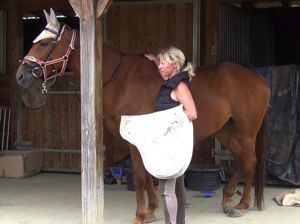
Because we were focusing on her friend's saddle-trauma (photo, left), Odette's trauma work was interrupted for a while, and meanwhile Hope began to accept her saddle without anxiety.
The amazing thing is that when Gaby tried again with the Solocomb it was as if there had never been a problem - we couldn't believe it when Odette just stood and snoozed while her whole mane was trimmed!
Re-Training A Stressed Horse
Odette's training work was an important part of establishing a trusting relationship with humans. All her associations with training were from her previous racing career, and it was clear that no-one had taken much time to build any kind of a relationship with her, or even carry out basic handling in a way she could accept and relax with. This meant that when I first took her to the arena, I was particularly careful to give her plenty of time, and only progress at the pace she was able to in relaxation. The first several sessions consisted of simply leading her around the arena, doing nothing more than stopping and walking on. When she stopped, she would show all the anxiety of a stressed horse, and I just waited, stroking her until she came back to me in her eye, relaxed, and we would move on again. I noticed that talking to her had a very calming effect, as well as just doing everything slowly, calmly and gently. We notice when we watch video of ourselves handling horses in this way that we almost look like we've been put into slow motion! This is what our intuition and experience tell us is the way to earn horse's trust. So much of the handling of horses is done with fluster, hurry and raised voices that it's not surprising tension is the result.
I found Odette to be a quick learner, and we moved from stopping and walking on, to some gentle yielding work - teaching her to soften and move away from pressure on her side. She was less comfortable with me being further back at to her side, and it took some time to teach her to go forwards without me at her head, as well as accept the pressure on her side which was clearly a completely new feeling for her. Occasionally she would show signs of the stressed horse she had been by pinning her ears in response to the me touching her side, but it quickly dissolved into the relaxation which is the unfailing response to contact yielding. Soon she had relaxed enough in the in-hand work that we could progress to the lunge.
Everything about Odette's conformation and training was about speed, so the main challenge in her lunging work was to slow her down and teach her to carry herself rather than perpetually falling forwards. I found her very receptive to my aids and even mental communication on the lunge, and she quickly came round to working with a consistent longitudinal stretch. I lunged her for a good three months in this way until she was strong in the musculature for stretching as well as slowing down and balancing herself, and moving in and out on the circle. The only stressed horse signs she showed at this stage were when she went into canter, and her lack of balance quickly sent her into a panic which took a lot of patient steadying work to bring her out of. To persist with this would have triggered a vicious circle and broken down the mutual trust we had built until then, so I decided to leave the canter for the moment.
The first time I rode Odette reminded me a lot of the first times I had taken her to the arena. I could feel that every muscle in her body was on alert, waiting for one trigger that would set of her stressed horse reactions. So in the same way as before, I just said very gentle, calm and patient, and did a small amount of walking around before stopping. Once she realized that I was not gong to be forceful with her, she seemed to fully accept me on her back, and schooling work could begin.

I soon found that despite her racehorse conformation, she had a very strong postural engagement, and it only took some yielding onto the bend and gentle shoulder-in to cause her to lift her body into this new way of carrying herself. I always feel that the very first time a horse comes onto the ring of engagement has a magical quality about it, and I like to think it must feel the same for the horse. Certainly with Odette, the relaxation that engagement brings about was obvious. Because of her long backlogs - made for galloping at full speed - she has a very strong thrust in each stride, even in walk, and this required first a very mobile seat to follow and harmonize with her movement, and then a strong postural influence from the rider to actually get her joints to flex so that her pelvis could begin sitting over her hind-legs more.

Because of her relentless forwardness, it would have been very easy to let a fulcrum establish itself in the rein contact, as a way for us both to balance against the flow of movement, but of course the goal of real dressage it to create postural balancing within horse and rider, so that movement can flow uninhibited by the bit or any other form of blocking. I therefore had to be careful to do frequent yielding of the rein contact to make sure that there was no leaning or blocking going on, and at the same time train Odette to come back to my seat with all the gymnastic alterations that this requires. Although this was a slow process in the face of her conformation, she concentrated extremely well in her work, and I felt that her learning to come back to me without being held was also an important emotional step for her in letting go of the old anxieties of the stressed horse she used to be.
One of the most difficult things for Odette at first in ridden work was accepting the leg. Of course, as a racehorse she would never have been used to the feeling of a leg down on her side, but it was also a sign of her underlying tension stored in her diaphragm that she was so sensitive to my leg. I didn't push for her to accept my leg until she was ready to, and it would be a good few years before I could really put it on her side without the stressed horse response of tightening and speeding up. The first step was get her listening to my seat, and this would eventually earn enough trust with her, as she realized how I was able to make her feel more balanced, that she could begin to accept the leg.
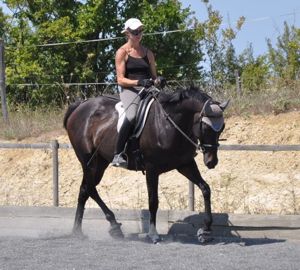
The main manifestation of her crookedness in her initial training was the fact that she pushed me off the right side of her back markedly, requiring me to put a lot of weight down my right side to keep a central position. This interestingly was the opposite from the usual pattern for a right-concave horse - which she clearly was - as normally this crookedness pattern pushes the rider off the left side, over to the right. I felt this unusual pattern was probably the result of a fall, and I was always aware of a lot of holding and stiffness in her right hip/sacroiliac. Whenever we came up to a block, she would have a Craniosacral session from Camille, which she always responded very well to, allowing her to move forwards again in her training.
It was a good three years or so into her re-schooling that her crookedness really began to fully unwind, and as the compensations she had developed in her previous career released, she felt increasingly uneven in her work, falling in a lot on the right rein and finding it hard to bend left. I worked through this in our usual way, taking her into her crookedness instead of trying to compensate for it, and gradually her pelvis started to loosen to allow her to align her right hind-leg and step under more with the left one.
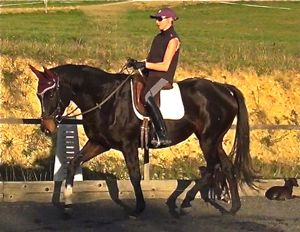
As this straightening has come about, she has been increasingly able to collect and come up onto a higher head-carriage, without any interference from the bit. I also realized when riding her the other day that I had completely forgotten how intolerant of the leg she used to be - now I am able to use it normally to straighten and bend her without any tension as a result.
I didn't feel Odette was ready for canter work until relatively recently in her training, and first attempts resulted in a very flat, unbalanced scramble, punctuated by the odd buck. This was on the right rein, because at first she was totally incapable of giving me a left canter no matter how hard I tried. The right canter improved relatively quickly however, and she started to be able to engage in it and show signs of the totally different quality of canter that she would one day be capable of. We feel that there is a big leap up in the postural strength required for a horse to canter in engagement compared to trot, and this is why, for horses that don't have a naturally easy canter it can take years and years of strengthening engagement in walk and trot before working on the canter constructively becomes a possibility.
By the time Odette was ready for canter, she had lost all of the stressed horse panic reaction to it that she had shown on the lunge, and her bucks were only a result of the remaining tightness in her pelvis. Her straightening work continued to the point where her left bend was dramatically improved, and she would accept my outside leg positioning her quarters onto the bend and asking her for traverse and half-pass steps in walk and trot - something she had violently rejected before.
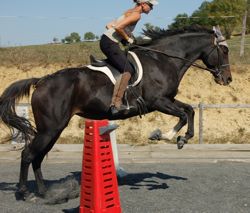
I had always used a small jump (she didn't always do a small jump over it!) to help to initiate the canter with her, and this was how I got the first left-canter transitions, but we were only able to get a genuine left canter transition when her straightness had improved enough. It was a wonderful feeling when we finally got the transition which had seemed so impossible before, and started to be able to work on the canter, which was surprisingly balanced thanks to all the preparation. This experience confirmed my view that it really is worth being patient with the canter, however slow it may seem.
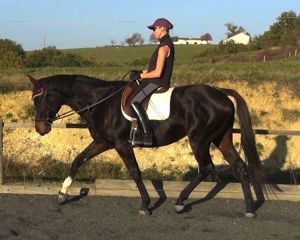
Odette's training transformation shows how a gentle, patient approach, firmly founded on work in engagement can help to turn what was the epitome of a stressed horse off the track into a calm and elegant dressage horse. Of course everything about her new life was equally important in this transformation though, and this is the power of the holistic way.
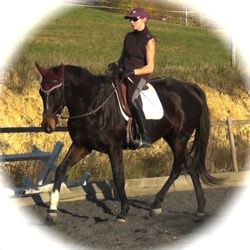
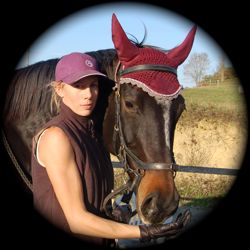
Return from Healing A Stressed Horse: Odette's Story to the Happy Horse Training homepage
The pages on HHT are so wide-ranging and interrelated that we strongly recommend you look at the site plan to find other subjects that may interest you.
New from HHT!
AudioRide is a series of exercises designed to listen to while you ride.
Audio descriptions guide you through each step of developing a balanced, dynamic connection with the horse through your position.
This truly innovative learning tool gives you a whole new way of being guided in your riding, in a calm, clear, step-by-step way.
Free Download! Introductory Exercise: Riding in the Now
The Gymnastic Rider eBook
Now available exclusively from HHT!
A unique, comprehensive guide to practical rider biomechanics. This professionally produced eBook takes the rider through the process of developing their body in the specific way that brings the horse's movement into harmony and balance, without force and constraint. Click here for full details, and to download the 15-page introduction to the book for free.
Join the Happy Horse Training group on Facebook!
See and share topical info, news and photo's, and take part in lively discussions.
Click here to go to the HHT group (make sure you log into fb first) and then click on the 'join' button at the top of the page.
Join the Whole Horse Newsletter!
HHT's free monthly newsletter giving you wide-ranging and intelligent insights into holistic horsemanship.
Just enter your details below to join.
Free bonus on the riding position with all new subscriptions: Ten Top Tips To Instantly Improve Your Connection With Your Horse.
Click here to see back issues of The Whole Horse newsletter
Train Your Horse
The Holistic Way
How To Train A Horse Without Force
is a unique guide to training horses through energetic connection and
gymnastic training. Part 1 covers everything on the ground, from
handling to the lungeing technique that develops strength, straightness
and engagement. Comes with a free eBook supplement on Horse Trauma.
Click here for more details.
"As a student of Zen Buddhism for nearly three decades, I've often wondered when someone was going to write the book on Zen and the art of horsemanship, and I think that your emphasis on mindfulness and energy connection gets right at the heart of the matter."
- Prof. Teresa Lloyd, U.S.
Do You Have
A Horse Story
To Share On HHT?
So many people have been through
wonderful experiences with horses, whether in training or otherwise. If
you've made a change in a horse's life - or one has made a change in
yours - tell us about it here.
Learn The Natural Barefoot Trim - The Simple Way
The Simple Seven-Step Natural Trim is a comprehensive step-by-step guide to a cutting-edge barefoot trim. Click here to find out more.
What people say about HHT:
"The riding instruction is outstanding, if instructors in the UK taught this way there would be a lot of happy riders and horses."
"The riding tuition exceeded my hopes and expectations by a long way; giving me an exciting new facet to horsemanship which is lighter. more subtle, more elegant and more meaningful. It is as if a new door has opened bringing more sunlight and air."
"My goodness - what a change has taken place in my riding. I think that I'm starting to sit 'into' the horse rather than on top of him. I felt my horse's movements in a way that has almost never happened before"
Click on Testimonials for more





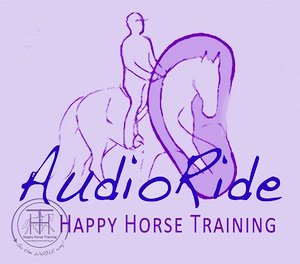




New! Comments
Anything to say about this page? Leave your comment in the box below.